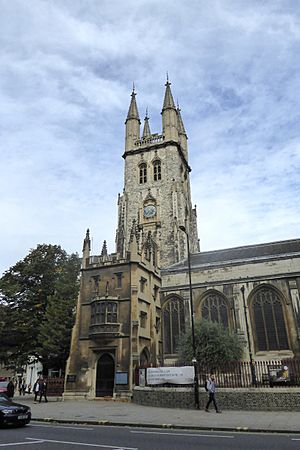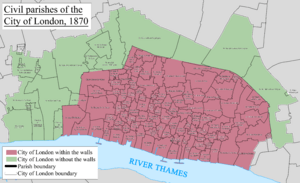St Sepulchre (parish) facts for kids
Imagine a really old neighborhood area called St Sepulchre. It was once an ancient parish, which is like an old local district. This area was split into two parts: one part was inside the City of London (the very old heart of London), and the other part was outside. Today, this old area is part of modern neighborhoods like Smithfield, Farringdon, and Clerkenwell.
For things like local services and charity work, this parish was divided into:
- St Sepulchre without Newgate: This part was inside the Farringdon Without area of the City of London.
- St Sepulchre Middlesex: This was a smaller part to the north, located in Middlesex. Since 1965, when modern London boroughs were created, this part has been in the London Borough of Islington.
Today, the church part of St Sepulchre covers mostly the same land, plus a bit more to the southeast. It has one main church, which is known as Holy Sepulchre London.
Contents
A Parish Divided: St Sepulchre's Story
The church of St Sepulchre-without-Newgate was built a very long time ago, probably in the early 1100s. It was right next to Newgate, one of the gates in London's old city wall.
For local government purposes, this area was split into two civil parishes. Both were called St Sepulchre, but the part inside the City of London was also known as St Sepulchre without Newgate.
The River Fleet, which is now a covered-up river flowing under Farringdon Street, formed the western edge of both parts of the parish. On the other side of the river was the area called Holborn.
Why St Sepulchre Was Split
The number of parishes in England grew a lot, especially in the 11th and 12th centuries, as more churches were built. This often led to larger parishes being divided into smaller ones. This process mostly stopped around 1180 when new church laws made it very difficult to split parishes or change their borders. By then, parishes usually had their final shapes.
The City of London's power extended beyond its walls long before the Norman Conquest in 1066. The City's different areas, called Wards, were also forming around that time. Because of this long history, the parish of St Sepulchre has likely always been split into its City and northern parts.
The northern border of the City in this area, which also divided the two St Sepulchre parishes, was originally partly formed by a stream called the Fagswell Brook (which is now underground). This border was marked by special boundary stones called West Smithfield Bars by 1170. Today, the City's border here, which runs near Smithfield Market, follows Charterhouse Street.
St Sepulchre without Newgate: The City Part
The civil parish of St Sepulchre without Newgate was a part of the Farringdon Without area within the City of London.
After 1547, this part remained connected to the main church. More recently, other church areas rejoined, so the church parish is now mostly just the original Holy Sepulchre church. The official name for the Church of England parish today shows this history of division and rejoining: St. Sepulchre with Christ Church Greyfriars and St. Leonard Foster Lane.
St Sepulchre Middlesex: The Northern Part
The civil parish of St Sepulchre Middlesex was located in an old division of Middlesex called the Ossulstone Hundred, and later the Finsbury Division. For church purposes, these two civil parishes were connected until 1547. Then, the Middlesex part split off and joined other areas to form a new, separate church parish.
However, this "daughter" church parish has since rejoined the original St Sepulchre church parish. Since the 1800s, this area has generally been seen as part of Clerkenwell, even though it was never officially part of any Clerkenwell administrative or church area.
In 1900, St Sepulchre Middlesex became part of the Metropolitan Borough of Finsbury. Then, in 1965, it became part of the London Borough of Islington.
The End of the Old Parishes
The civil parish in the City of London was officially ended in 1907. The civil parish in what is now the London Borough of Islington ended a few years later, in 1915.
The church parish, which had been limited to the City part since 1547, merged with two smaller parishes to the southeast in 1954. This new, larger church parish became the successor to about 95% of the original land, plus the added areas. Its full name is St Sepulchre with Christ Church, Greyfriars and St Leonard, Foster Lane. It has one church, which is known as Holy Sepulchre London. A very small part of the original parish land, near Barbican tube station, was not included in this merger. However, today, people can choose to worship at any church they like. The church has followed a "low church" (Protestant) style of worship since the Marian persecutions in 1555, when its vicar was executed. It is the largest church (not a cathedral) in the City of London.
Population Changes Over Time
Here's how the number of people living in these areas changed over the years:
- St Sepulchre, City of London
| Year | 1871 | 1881 | 1891 | 1901 |
|---|---|---|---|---|
| Population | 3,701 | 2,166 | 1,754 | 1,160 |
- St Sepulchre, Middlesex
| Year | 1871 | 1881 | 1891 | 1901 | 1911 |
|---|---|---|---|---|---|
| Population | 2,888 | 2,392 | 1,972 | 1,503 | 1,192 |




